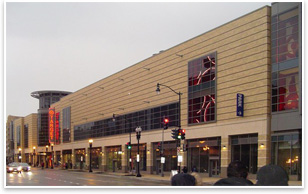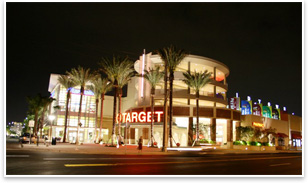AIA President Lauds Target’s Designs as Smart Business Strategy
by Tracy Ostroff
Contributing Editor
 Summary: AIA President Marvin Malecha, FAIA, issued a Presidential Citation earlier this spring to the Target Corporation praising the company’s “leadership in demonstrating the value of design as a smart business strategy that builds brand loyalty among its team members, its guests, and the global communities it serves.” Malecha read the citation during an AIA Board meeting in Minneapolis, Target’s home base. Target Design Chief Richard Varda, FAIA, discusses here how the retailer is, in the words of the citation, “promoting stewardship of the environment and making design thinking not a luxury, but a way of life.” Summary: AIA President Marvin Malecha, FAIA, issued a Presidential Citation earlier this spring to the Target Corporation praising the company’s “leadership in demonstrating the value of design as a smart business strategy that builds brand loyalty among its team members, its guests, and the global communities it serves.” Malecha read the citation during an AIA Board meeting in Minneapolis, Target’s home base. Target Design Chief Richard Varda, FAIA, discusses here how the retailer is, in the words of the citation, “promoting stewardship of the environment and making design thinking not a luxury, but a way of life.”
Richard Varda, FAIA, is the AIA Minnesota president-elect.
Varda and Target’s Jim Miller spoke in 2008 with Andrew Blauvelt, head of the Design Studio at the Walker Art Center in Minneapolis, about the company’s new store in Bloomfield Hills, Mich., home of the Cranbrook Campus, designed by Eliel Saarinen, and where son Eero lived and worked. The trio discussed how the context of Saarinen’s work influenced the retailer’s designs for the site. Scroll down on the page to read the interview.
1. Richard Varda, FAIA, vice president, Store Design, Target
2. Target’s first store in the nation’s capital is in the Columbia Heights neighborhood right off the Washington Metro system.
3. This Miami Target is sited in a multi-level shopping center and adjacent to parking.
Images courtesy of Target.
View the slideshow.
AIArchitect: How does Target see its investment in design as a good business strategy?
Varda: The Design for All campaign is very much the DNA in the company and informs how we design products, how we select designers, everything we put in the store, and then the design of the store itself, which we are constantly evolving.
When I came to Target in 2001, and interviewed with CEO Bob Ulrich, who retired last year, we talked a lot about design. His vision really was that design was what differentiated Target and its brand and set us apart. The idea that design doesn’t have to be expensive or only for the elite, but it can be for everybody, particularly when you have a large company that has the resources to create quality design with the right expertise and apply it to very inexpensive products because of mass production. When I came to Target, he said he wanted me to be a part of upgrading the environment of our stores and how we fit into communities to really reflect that brand differentiation.
AIArchitect: How often do you customize your stores?
Varda: We do have a prototype store, but we probably modify at least two-thirds of the stores we put into communities to work with their context. Very often, that means we are working within a developer’s retail center, and the developers are doing something to really key to the community and working closely with the city staff. We support their efforts and modify our stores to fit in with a more unified retail approach. That applies to planning as well as the design of the building.
About 20 percent of our stores are highly customized because of unique sites or other reasons, and those are then driven by the size of the site, the configuration of the site, and the amount of land available. We almost always work closely with the cities and their planning staffs on those designs. City planning staffs are very particular about controlling retail designs across the country, probably more than any other building type.
AIArchitect: Are city planners usually on the defensive when you come to them with plans for a new store?
Varda: In general, they are suspicious and a little confrontational with any retail developer, and it’s partly because of big boxes, but it’s even more so because retail architecture and retail planning have had a tradition of being one of the least attended to segments of our profession. The quality of retail design has improved dramatically in the last 10 years, and partly that is a result of pressure from cities to do better. They are only now getting to be a lot more understanding of the fact that we work with them and support them.
AIArchitect: How do you connect store design with profit?
Varda: It is a little difficult to connect design and the value of design to the numbers. But we can compare stores, make assumptions, and learn the value of a new store built to our current prototype versus older ones. We have taken a lot of older stores and remodeled them—put on a whole new front and the whole new interior front end—and have seen the sales lift that comes from that.
What that number has told us is that it is generally justified, whenever we have done a remodel, to spend the money to bring the store up to the new design standards. That’s a very interesting discovery that took a few years to find out. We can do the analysis and understand and bring everything back to net present value, and that’s how we measure each project. All the components of the project—cost, the investment in custom design, the operation of the store, and the expected sales—are put into the formula to tell us what the net present value of that investment is. It has to reach a certain hurdle for us to go ahead with the project.
 AIArchitect: Will Target take advantage of non-traditional stores, types left vacant in the current economy? AIArchitect: Will Target take advantage of non-traditional stores, types left vacant in the current economy?
Varda: We keep track of that. In 2000, Montgomery Ward’s went bankrupt, and we did buy 35 of their properties and renovated or rebuilt those into Target stores, so we have a track record. We are keeping a close eye on what is becoming vacant, what our competitors are doing, and looking beyond retail competitors, too. Car dealerships are often in a location where they have a large enough site and are zoned properly. We’re not planning on taking any dramatic action in the very near future, because like everyone else we are trying to be very careful with capital in the economic times. But, as the next couple of years unfold, the economy starts to recover, and we really see who is still there and who is not, I’m sure there will be some interesting opportunities.
AIArchitect: What are some ways Target is pursuing sustainable practices?
Varda: To a certain extent, this is also part of our DNA, because we have to compete with the largest company in the world, and their goal is the lowest prices, we have to hold our expenses down. As a result, we have a detailed focus on energy and controlling energy use, and we are constantly making modifications to reduce energy consumption. It also means that we use some of the simplest and locally sourced materials. We’ve been working with the USGBC to make sure our new prototype reached their Citation level that they are setting up for the new guidelines for retail, and our current prototype is pretty much there.
We now have four LEED™-Silver stores. They can add cost, so we are careful about each of the things that we do to get to those LEED levels. We are probably more interested in the energy side, so we’re part of the EnergyStar® program. We have had all of our stores evaluated and feel that virtually all the stores would score high enough to receive the EnergyStar citation. Now we have to have a professional engineer visit each store and evaluate them before we can get that. But that does cost a bit of money, so we are evaluating the value of doing that for all the stores. But I think that you’d find that our performance in that program is the best of any retailer, or very close to it.
We have 18 stores, almost all in California, with photovoltaic installations across the roof. We have a team that’s constantly watching for opportunities to do more of those. It usually takes a partnership with the utility or a governmental entity that’s providing some of the subsidy to make it happen financially. We can go on and on. There are a lot of things we do in the building and recycling construction materials that all fit into LEED classifications. Probably half of our stores go into sites that were already used for something else. There’s a great deal of remediation of brownfields. Going forward, because of the economy and changes in demographics, the bulk of our stores will be going into already built up urban zones and therefore into properties that are being redeveloped and cleaned up. We may see a lot more LEED-rated stores going forward.
 AIArchitect: Do you work with outside firms? AIArchitect: Do you work with outside firms?
Varda: It’s a very well-developed program. Our internal group of architects, engineers, and store planners is about 300 people. We are building a full complement of new stores, which has been upped to 100 per year. We can’t do more than about 20 percent of those internally with all of our other responsibilities, so we have consultants who do the rest. We have four firms that have been part of our program for a long time. We often work with others not in the program because developers all over the country will have their own architects developing their centers and ideas for what our building should be like.
AIArchitect: How does the store design work with the strong aesthetics of the designers whose products you market?
Varda: We see there is a Target brand that very much has an attitude about design. We try to make sure our stores address that attitude. We assume it will come together if we all understand what the Target brand is from a design standpoint. We have spent a lot of time internally clarifying and defining what that is, so I think our stores are in sync with the designer products going inside the stores.
AIArchitect: Will “Design for All” still be the mantra going forward in 5 to 10 years?
Varda: I think it is going to stay our core differentiation and will probably even receive more emphasis going forward. As the American public becomes more educated to demand and expect better design, and as they become wealthier, as we expect over time they will, that will even make that demand and expectation greater. I think we are well positioned and will continue to emphasize being design leaders in how projects fit into communities, what our stores are like inside and out, and, in particular, the product that we provide within our stores. So the emphasis will still be there and will probably be an even greater part of our mission as time goes on. |



